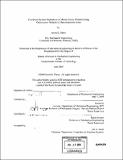Coordinate system dependence of muscle forces predicted using optimization methods in musculoskeletal joints
Author(s)
Pierce, Janine E. (Janine Elizabeth), 1980-
DownloadFull printable version (11.85Mb)
Other Contributors
Massachusetts Institute of Technology. Dept. of Mechanical Engineering.
Advisor
Guoan Li and Derek Rowell.
Terms of use
Metadata
Show full item recordAbstract
Optimization methods are widely used to predict in-vivo muscle forces in musculoskeletal joints. Moment equilibrium at the joint center (usually defined as the origin of the joint coordinate system) has been used as a constraint condition for optimization procedures and the joint reaction moments were assumed to be zero. This research project, through the use of a three-dimensional elbow model, investigated the effect of joint center location on muscle forces predicted using a nonlinear static optimization method. The results demonstrated that moving the joint center medially and laterally along the flexion-extension axis caused dramatic variations in the predicted muscle forces. For example, moving the joint center from a position 5 mm medial to 5 mm lateral of the geometric elbow center caused the predicted biceps force to vary from 12% to 46% and the brachialis force to vary from 80% to 34% of the total muscle loading. The joint reaction force reduced by 24% with this medial to lateral variation of the joint center location. This data revealed that the muscle forces predicted using optimization methods are sensitive to the joint center location due to the zero joint reaction moment assumption in the moment constraint condition. For accurate prediction of muscle load distributions using optimization methods, it is necessary to determine the true joint center location where the condition of a zero joint reaction moment is satisfied. Furthermore, improvements to the current optimization methodology were suggested. Incorporation of the 3D joint center location, as three unknown variables, into the optimization program was proposed, and this procedure was investigated for a pilot case incorporating one of the joint center components (y-axis variable) into the optimization. (cont.) This thesis work indicates that all previously published data on muscle and joint loads predicted via optimization methods should be revisited since the joint reaction moment was eliminated in those works.
Description
Thesis (S.M.)--Massachusetts Institute of Technology, Dept. of Mechanical Engineering, 2004. Includes bibliographical references (p. 143-147).
Date issued
2004Department
Massachusetts Institute of Technology. Department of Mechanical EngineeringPublisher
Massachusetts Institute of Technology
Keywords
Mechanical Engineering.